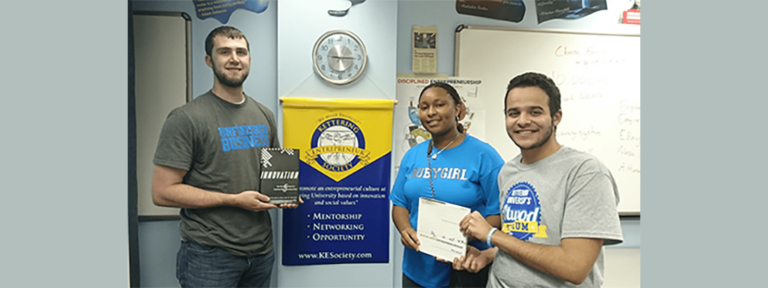
“Putting this (Internet of Things) together, making this all work is not easy and not easy means opportunity.”
Undoubtedly, the alarm clock is the first thing that meets an individual’s eyes when they wake up in the morning. The sound is obnoxious. The flashing lights are disturbing and its persistence indicates that it’s time to start doing something different. But what if the alarm clock did more than just annoy folks every morning? What if the alarm clock was smart and helped you rather than disturb you?
Brennen Gleason, Chelsea Carter and Ahmed Saad set out to improve the alarm clock during the latest Kettering Entrepreneur Society challenge. The challenge: connect a current household product with the Internet of Things to improve its efficiency and utility. The Internet of Things is a broad term used to describe how our daily lives can connect to the internet to make tasks easier to accomplish.
Related: |
"Putting this (Internet of Things) together, making this all work is not easy and not easy means opportunity,” said Kirsten Billhardt ‘96, marketing strategist for the Internet of Things at Dell, during a campus presentation in July 2015. “The reason it's not easy is because you are integrating the information world with the operational world."
Gleason’s team chose to bring the old-fashioned alarm clock to the modern age.
“It was selected because we had the greatest plan for the product,” Gleason said. “Our main focus was to help mothers. If the product was valuable, we knew that mothers would network and market the product quickly through word-of-mouth.”
The concept: a single main alarm clock rests by the bedside of the person leading the family. This device controls satellite alarm clocks scattered in bedrooms of the rest of the family. The main hub is connected to the internet which allows it to receive data on traffic, accidents, weather and any other nuisance that might cause the morning to deviate from the norm. Based on the updates the main clock receives, the precise time it rings will adapt based on how long it will take to get the entire family packed, prepared and ready for the day.
“We are learning how to look at the customer’s needs first and then work backwards from there,” Gleason said. “This clock integrates the outside world to your daily rhythm.”
For example, if an unexpected snowstorm occurs overnight, the main alarm clock will automatically ring earlier than normal to allow for extra driving time. This will also set off a chain reaction for the satellite clocks that will adjust their set times accordingly.
Gleason and his teammates won $250 from the Kettering Entrepreneur Society for winning the campus-wide challenge. They beat out projects such as a driveway heating system that adjusts its temperature based on expected condensation, a drone landing pad that would indicate when a potential Amazon.com delivery was made and electrical outlets that could be manually turned on and off from a mobile device.
Along with being a member of KES, Gleason, a Mechanical Engineering major, is also completing the innovation-2-entrepreneurship (i2e) curriculum of study. The i2e classes emphasize coaching over lecturing, mindsets over routine coursework and hands-on creative experience over theory. Students in the i2e course of study begin by being exposed to innovation activities (engineering design and applied science), followed by an exploration of the mindset and activities of successful and failed innovators and entrepreneurs.
“The biggest thing that I’ve learned is how to create something with value and not just something that you think is cool,” Gleason said. “I’m learning how to create a business, not just an idea.”